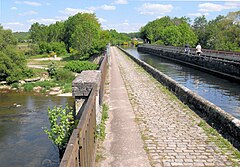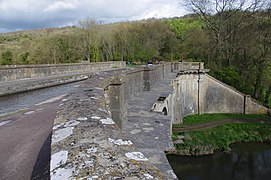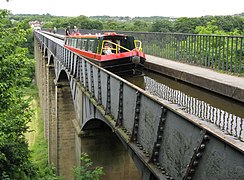Canal bridge
A canal bridge is a bridge structure that serves to lead a canal over another, lower-lying object.
In southern Germany, canal bridges were also called Brück Canal or Bruck Canal. In the course of the Ludwig-Danube-Main Canal , several canal bridges were built from 1836 onwards.
Well-known examples in Germany are the canal bridges of the Mittelland Canal over the Weser ( Wasserstraßenkreuz Minden ) and the Elbe ( Wasserstraßenkreuz Magdeburg ) as well as the canal bridge of the Oder-Havel Canal over the Berlin-Pasewalk-Stralsund railway north of Eberswalde .
Canal bridges can often be found in France , where canals were built in the 19th century even in topographically challenging terrain (e.g. Le Guétin canal bridge ). In England , the Dundas Aqueduct runs the Kennet and Avon Canal across the Bristol Avon . The Barton Swing Aqueduct from 1893 in Barton-upon-Irwell , England, is the world's only movable canal bridge.
Until the opening of the Magdeburg Canal Bridge in 1998, the Pontcysyllte Aqueduct (307 m; Wales ) opened in 1806 and, from 1896, the Briare Canal Bridge (662.69 m; France) were the longest canal bridges in Europe.
Further channel bridges (selection):
Bridge canal of the Ludwig-Danube-Main Canal over the Schwarzach
Trough bridge of the Mittelland Canal over the Elbe
Bridge of the Wiener Neustädter Canal over the Schwechat in Tribuswinkel near Baden
Combined canal and railway bridge over the Meurthe
Bridge of the branch to Épinal des Canal des Vosges over the Moselle
See also
Web links
Individual evidence
- ↑ Le pont-canal de Briare sur la Loire at aqueduc.info, accessed on February 27, 2019









